Heading to Sighnaghi Georgia?
Tucked in the Kakheti wine region, this stunning city offers its visitors a blend of history and winemaking traditions all wrapped up in a nice little picturesque bundle. You can start your day being amazed by the surrounding scenery as you wander along Signagi’s over 200 year old fortified walls and then step into a local family home and winery where you then experience the most incredible hospitality – maybe anywhere in the world.

Since our first trip in 2016, we’ve been constantly impressed by how the region continues to modernize and grow while still holding on to its strong historical roots. Back in 2016, this wine region was pretty rough around the edges with what it could offer tourists, but today it has grown into a place offering incredible experiences for its visitors full of traditional qvevri wine, cultural singing and dancing experiences, and of course Georgia’s famous hospitality.
As a new visitor to Sighnaghi (also sometimes spelled Signagi btw), there is so much to see, eat, drink, and experience, so we put together this guide to help you get the very best out of your trip to Signagi.
Let’s get started!
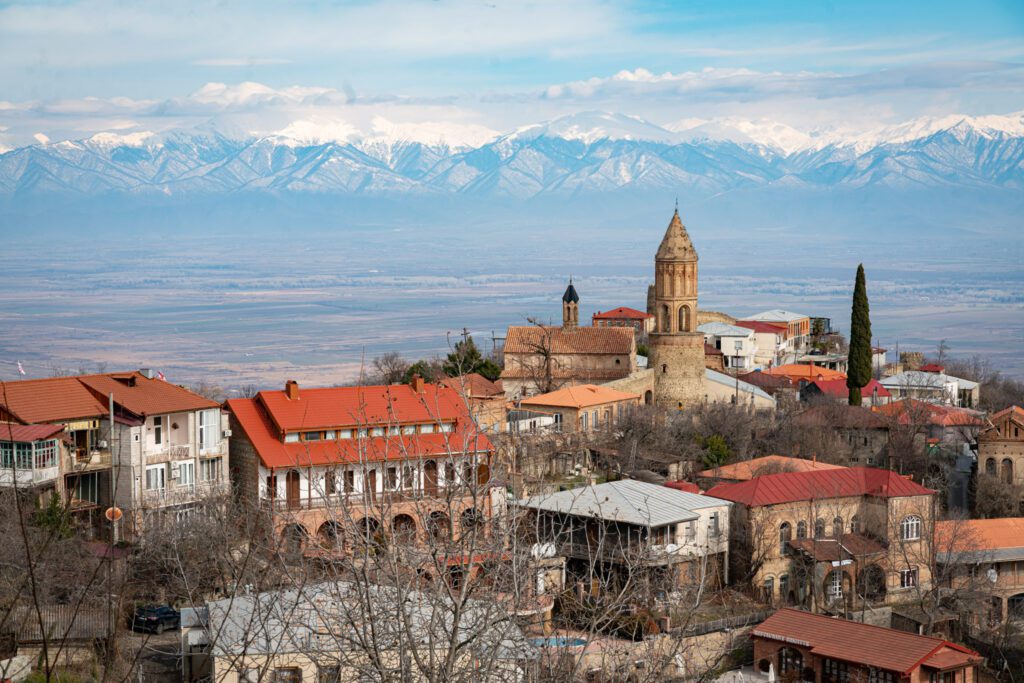
Exploring Sighnaghi: The City of Love
Known by locals for its romantic vibes, Sighnaghi is often referred to as Georgia’s ‘City of Love’. Located in the eastern part of Georgia, Sighnaghi throughout history has been a popular meeting place for couples. Its reputation for love is enhanced by legends and stories of love confessions and proposals; in particular, the story of the famous Georgian artist Niko Pirosmani (who is from a small town near Signagi) and his affection (some might even say obsession) for the French actress Margarita de Sevres.
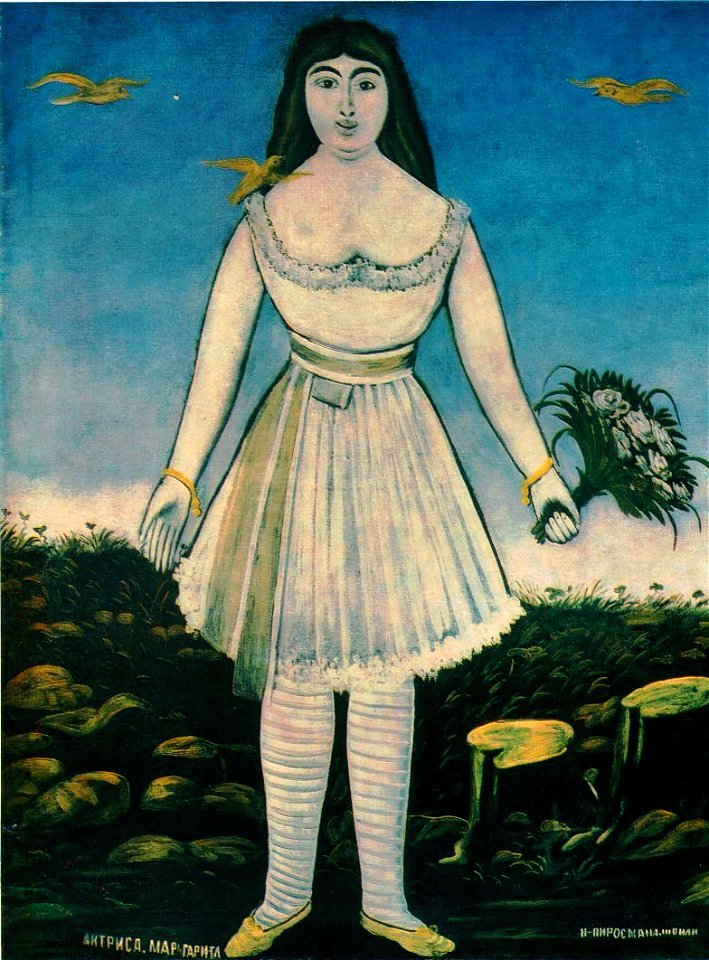
Pirosmani fell in love after seeing Margarita perform and then bought all of the flowers in the city to lay at her doorstep, there were so many flowers that it filled the street. She was so impressed she ran out and gave him a kiss – their one and only. While the story is more likely set in Tbilisi in 1909 the fact that he was from this region where people are known to be quite romantic is the main connection. Still a great story though, no matter where it was set or how embellished it might be today.
Anyway back to Signagi….
You can’t help but feel the romance in the air as you stroll through Sighnaghi’s old town and see firsthand the pastel-coloured buildings. Also, wandering along the cobblestone streets gives you stunning views of the Alazani Valley and the often snow-topped peaks of the Caucasus Mountains.
There is a wedding chapel here that used to be open 24 hours a day for any lovers wishing to elope, in fact when we got married in Tbilisi our Georgian friends asked us why we didn’t do it in Sighnaghi – as that’s where you go to elope!
These days (since covid boo) it’s open during regular business hours, no longer 24 hours, so you need to make an appointment to get married in Sighnaghi. Much less romantic…

History and Significance
Sighnaghi, derived from the Turkish word ‘Siginak’, means shelter.
Steeped in ancient history, archaeological finds suggest human presence in the area since the Paleolithic era, long before the official founding in the 18th century.
The city’s name, meaning shelter, was initially chosen by King Erekle II for strategic purposes, you can still see remnants of this today with the remaining medieval architecture like an 18th-century fortress, known for the 4km-long city walls, which are an impressive sight today let alone encountering them as an invading army a couple of hundred years ago. It would have been quite unnerving.
Beginning in 2005, Sighnaghi underwent a major reconstruction project which brought this quaint historical village back to life.
Today Signagi is a beloved tourist destination for history buffs, and wine lovers alike.
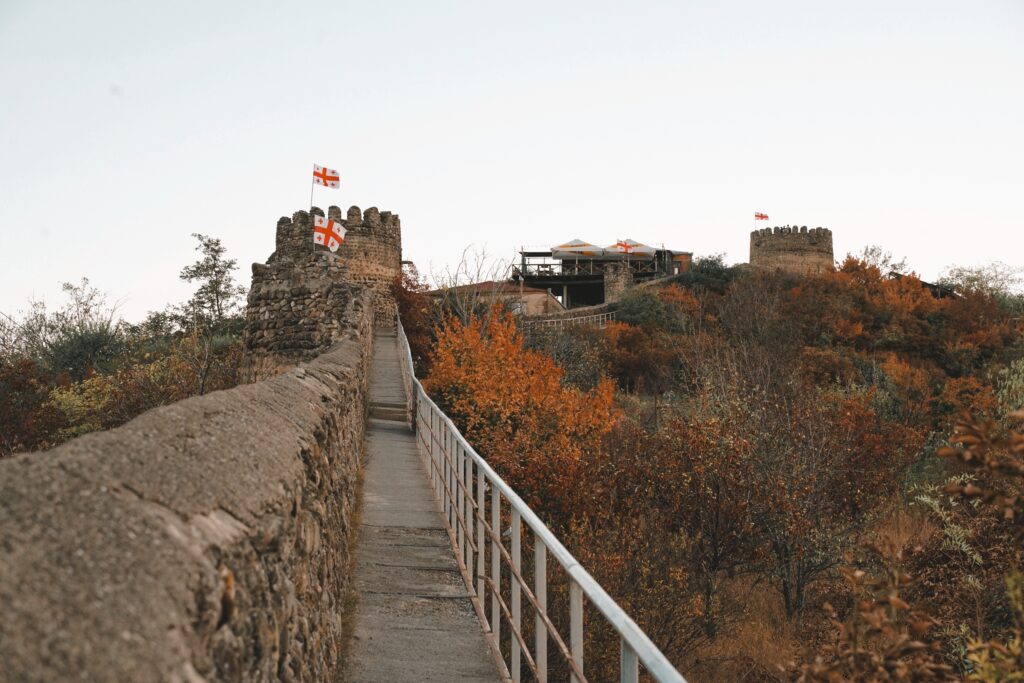
Must-See Attractions
- Start your time in Signagi with a walk along the city’s 4km defense wall, known as the Great Wall of Georgia. The wall offers breathtaking views of the Alazani Valley and the Caucasus Mountains.
- The fortress gate of Sighnaghi, dating back to 1762, stands as a testament to the town’s historical defenses and Georgian architectural prowess. It’s a great place to get some group pictures but please look out for cars!
- For art enthusiasts, a visit to the Sighnaghi Museum, established in 2007, is a must. The museum has an impressive collection including Stone Age archaeological relics, locally discovered ethnographic treasures, and notable artworks by the famous Georgian artist Niko Pirosmani (our lover boy mentioned earlier). These are actually original artworks so please don’t do what I did and step over the red line to get a closer look – you WILL set off the security alarms. WHOOPS!

Delving into Georgian Wine Culture
The Kakheti Wine Region, where Sighnaghi is located, is one of the leading producers of wine. Georgia has an 8000-year-old history of winemaking – the oldest on Earth, and Kakheti is home to three-quarters of the country’s vineyards, making it Georgia’s most important wine country.
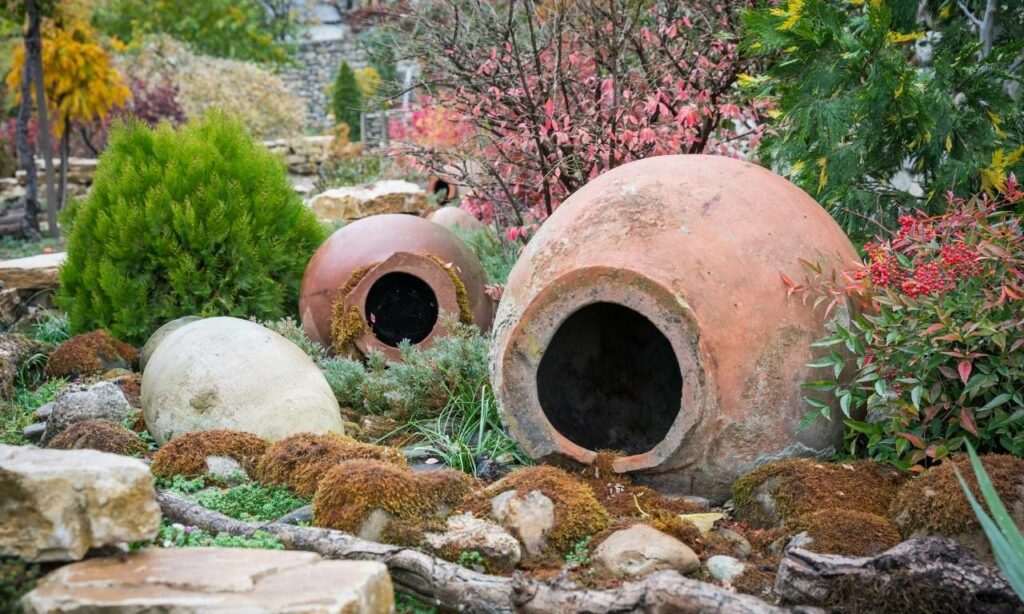
Qvevri winemaking, recognized by UNESCO as an intangible cultural heritage in 2013, involves using large, egg-shaped earthenware vessels buried underground in the winery or home marani (Georgian wine cellars). Grapes, skins, seeds and all, are placed into the qvevris to ferment using the natrual yeast found on the grape skins. This ancient tradition is still very much a part of Georgian culture today, and gives us some of the incredible and unique tasting wines including amber wine, that has become popular worldwide recently.
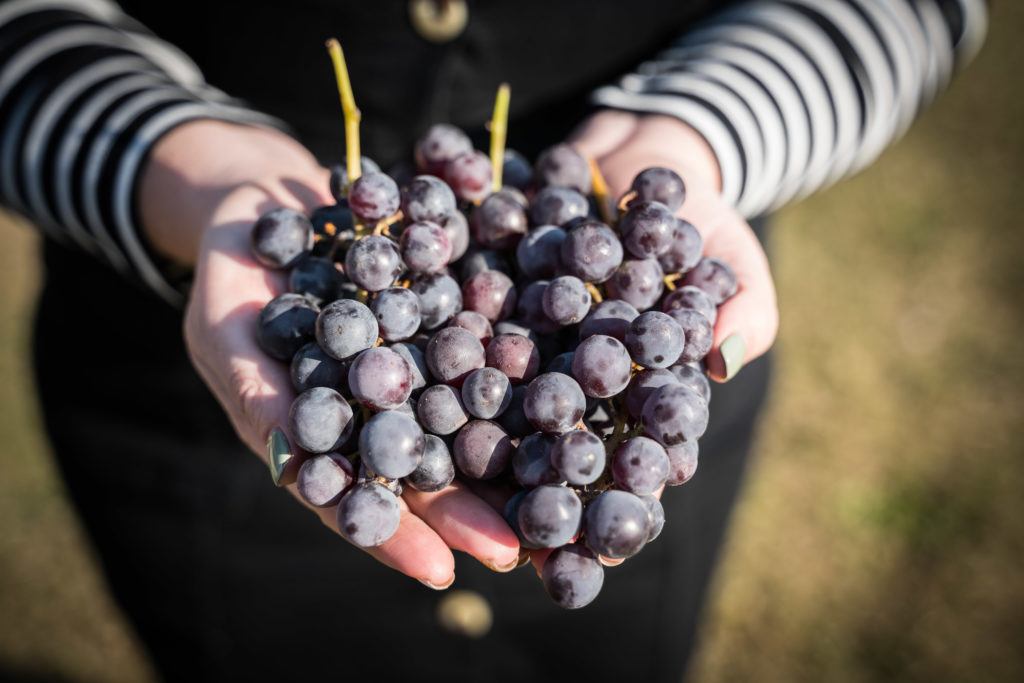
Popular local grape varieties include:
- Saperavi, nicknamed ‘black wine’ by locals, a rich, deep-coloured Georgian red wine known for its full-bodied flavour and strong tannins.
- Rkatsiteli white wines that are recognized for their citrus, green-apple, and subtle spice notes with a crisp acidity.
Wine Tastings & Wine Marani Experiences in Sighnaghi Georgia
Wine tasting in Sighnaghi is more than just turning up to a cellar door where you can taste a bunch of wines that have possibly been sitting there open all day, buy one you like, and then leave. Georgia wine tastings offer much much more.
You can expect: tours of the winery and marani by the winemaker themselves, insight into their family history of winemaking – sometimes with old family photos, clothing, and family relics and a sampling of various qvevri wine or more European style wine, either with delicious kakhetian cuisine or the simplified local nuts, raisins, dried plums, and cheese. It really depends on the sort of wine experience you book.
And yes, you need to book in advance!

During these wine tastings, visitors can also sometimes enjoy Georgian music and dance (Georgian people are very talented), enhancing the cultural experience of a Georgian winery visit.
You may even have your tasting accompanied by traditional toasts with your winemaker as tamada – this is a custom deeply ingrained in Georgian culture.
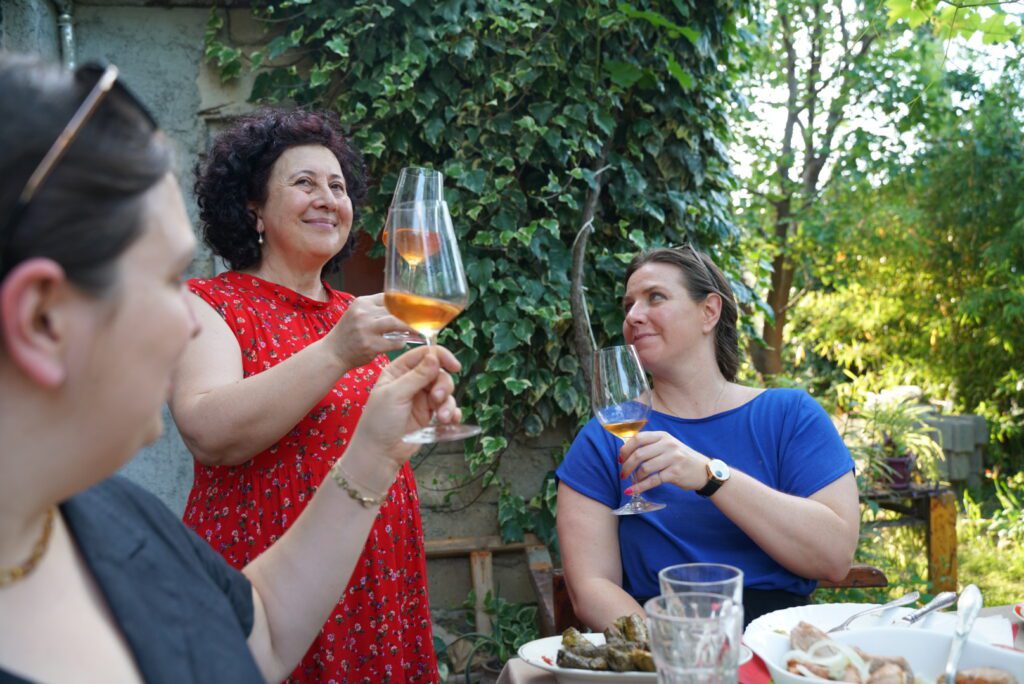
Note: Georgians don’t skimp on their wine pours and it’s best to either book a Sighnaghi wine tour with a professional guide and driver or to make sure the wine tasting you do is within walking distance to your hotel in Sighnaghi.
Culinary Adventures in Sighnaghi Georgia
For foodies, Sighnaghi is a culinary paradise. The city’s rich gastronomic heritage complements its vibrant wine culture perfectly. From traditional Georgian dishes to the local markets offering fresh, seasonal produce, you’re in for a treat!

Top Dishes to try in Signagi:
Nigvziani Badrijani – a delicious must try Georgian traditional dish with tender, fried aubergine (eggplant) rolls filled with a rich, spiced walnut paste and garnished with pomegranate seeds. Even if you’re not an eggplant fan – you might be converted after trying this dish!
Lobio – A dish made from stewed kidney beans, often seasoned with coriander, walnuts, and garlic, and served with a variety of accompaniments like pickles, fresh herbs, and cornbread. Served in a clay pot this is a perfect dish for vegetarians.
Churchkhela – a unique Georgian snack, resembling a candle in shape, it’s made from nuts like walnuts or hazelnuts threaded on a string and dipped in thickened grape juice, then dried to form a chewy, sweet, and nutty snack. Yum yum yummy!
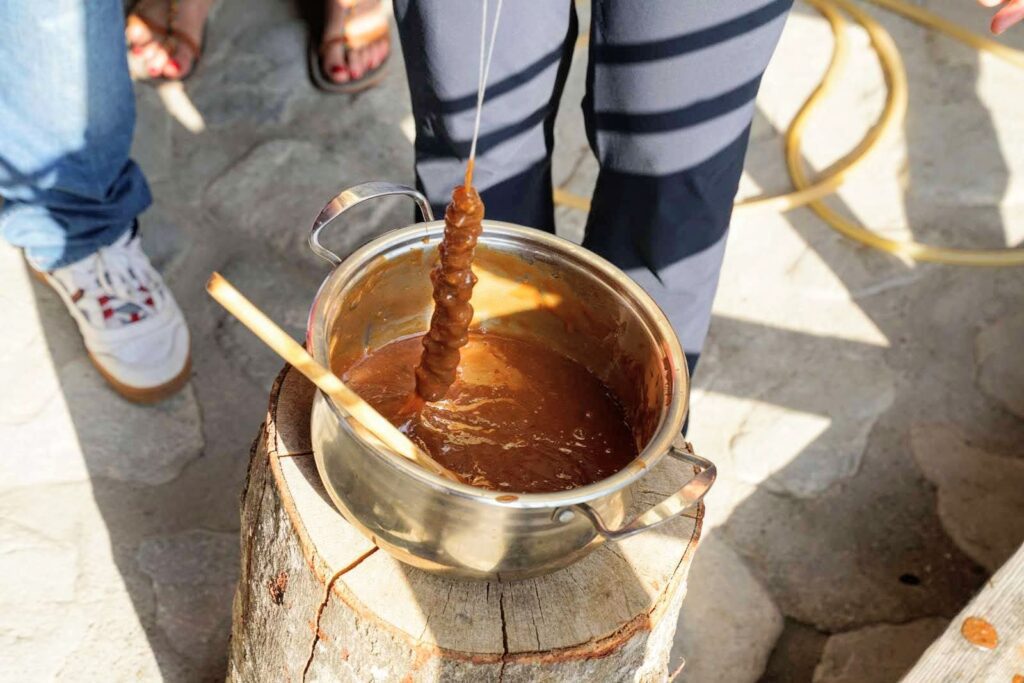
Best Restaurants Sighnaghi
Sighnaghi is home to a variety of restaurants that cater to different tastes and preferences, but any seasoned traveller knows no 2 restaurants are the same in quality, and you don’t want to end up eating at a dud when visiting Kakheti…ain’t nobody got time for a mediocre meal!
So here are our favourite’s that we eat at when we visit Sighnaghi:
- The Terrace Signagi – offers a delightful dining experience with stunning panoramic views. This restaurant serves a fusion of traditional Georgian flavours and contemporary culinary twists, all in a relaxed, inviting atmosphere.
- Amo – is a lovely restaurant known for its authentic Kakhetian cuisine, Amo has a cosy ambiance (great in winter time) and a menu that highlights local ingredients and traditional recipes.
- Okro’s Natural Wine Restaurant – this restaurant has a stunning terrace with views over the Alazani Valley, a full à la carte menu that highlights the rich flavours of Georgian cuisine, all complemented by their own-branded natural wines.
Local Markets
Local markets in Sighnaghi are also worth a visit, offering an array of Georgian spices such as adjika and khmeli suneli, essential for authentic Georgian cooking. Apart from spices, shoppers can purchase a variety of local items at the market including bottled wine including semi sweet wines and of course local qvevri wine, churchkhela, local fruit leather called Tklapi, local cheeses, and hand-knitted socks, soft animals etc.
The markets in Sighnaghi – while small – are a lovely place to explore in between eating and wine tasting.
Exploring the Kakheti Wine Region

Notable Wineries and Vineyards
I generally prefer to visit smaller family wineries in Sighnaghi when I visit, but I will give mention to Shumi Winery as even though they are a big corporation winery they do offer a great experience for tourists to this wine region. We visited Shumi when we first came to Georgia in 2016 and I was impressed by their collection of over 400 indigenous grape varieties and a fascinating museum with ancient wine artefacts.
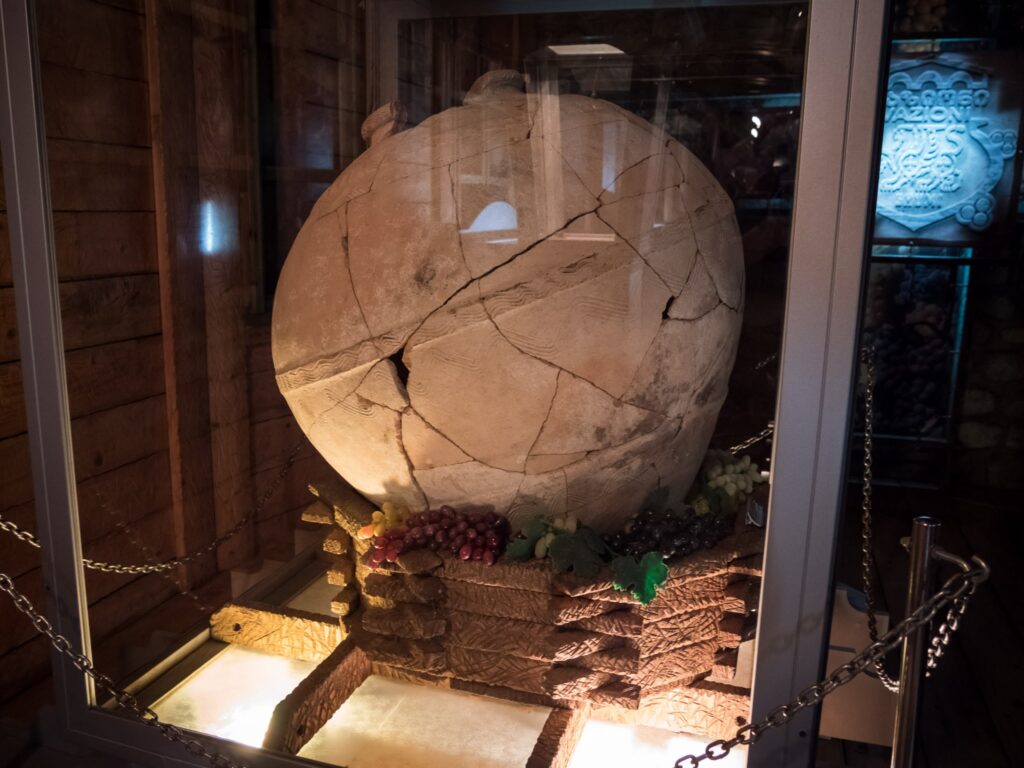
Fun Fact: Shumi Winery, takes its name from an ancient Georgian term meaning genuine, undiluted wine, and their winery logo has a griffin “Phaskunji” from Georgian mythology. This mythical creature is said to have brought the first grape bunch to humans, and thus people started growing vines across the earth.
If you’re wondering about what wineries I visit when I’m in Sighnaghi I have a full article of my favourite family wineries you can visit in this wine region that you can read here.
Cultural and Natural Attractions Near Sighnaghi Georgia

Ready for a break from the wining and dining? There’s heaps more to explore, while your stomach takes a break! Visit the Bodbe Monastery – this place is historically important as it’s built right over St. Nino’s tomb, the lady who brought Christianity to Georgia in the 4th century.
She’s pretty important in Georgia. There’s a working nunnery, a grand cathedral, and even a spring that’s said to work wonders for your health. In general it’s a lovely place to wander the gardens taking in the peace and quiet.
I’m not sure why, but all the nunneries have stunning gardens in Georgia. Just something that I’ve noticed and really love to explore personally.
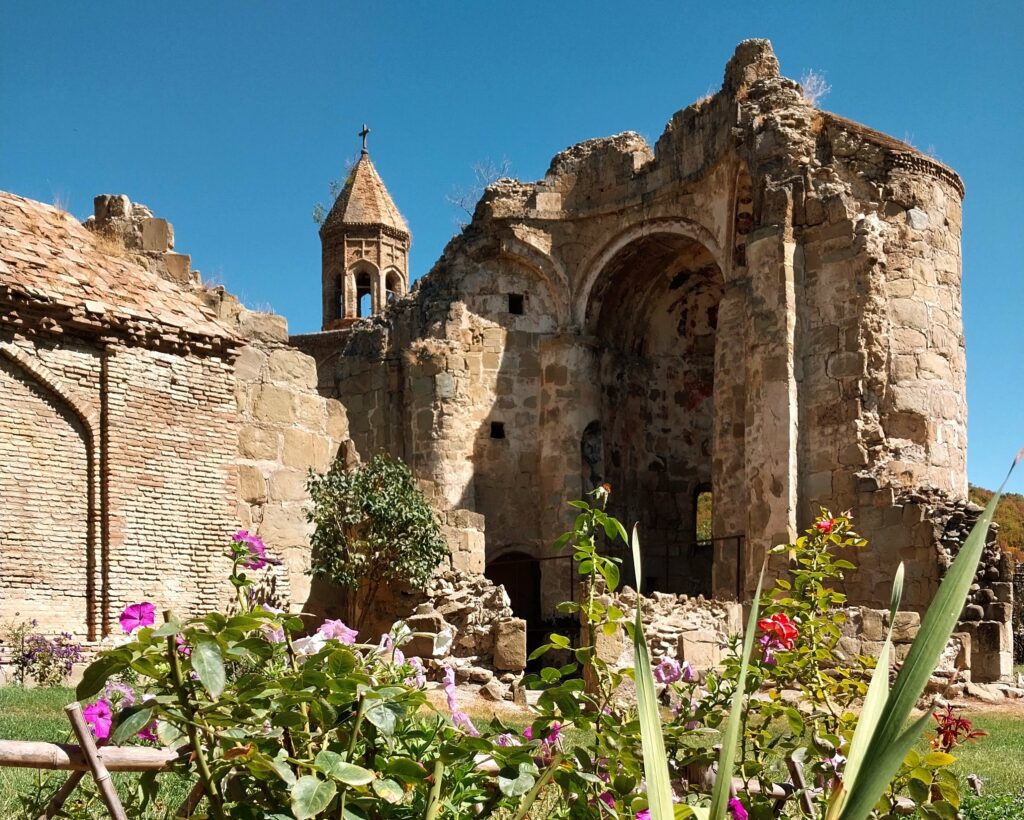
If you’re a fan of the great outdoors, check out Eagle Gorge in the Vashlovani area. It’s a popular spot for birdwatching and finding some rare plants. In this area, there are over sixty bird species to spot. Among them, keep an eye out for the rare nesting species like the black stork and Griffon vultures – they’re pretty special!
Whether you’re into history, nature, or just a bit of spiritual discovery, Kakheti’s got you covered – it’s not all about the vino! Just mostly about the vino…..
Where to Stay in Sighnaghi
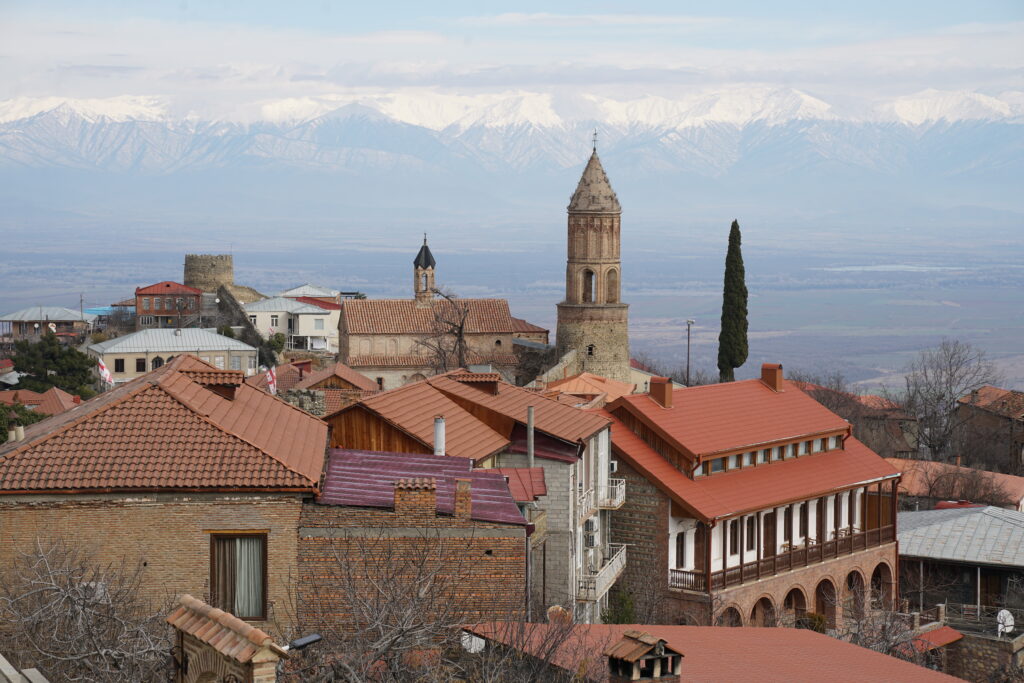
Sighnaghi caters to all, offering a variety of accommodations to match every budget and preference. From luxury spa hotels like Kabadoni to budget guesthouses like Royal Villa, you’ll find a variety of options featuring mountain views, private terraces, and quaint balconies, along with essential amenities like free parking and WiFi.
These are our personal top choices of where to stay. Some hotels are located in Signagi town, and some are just a bit out of the city, but worth staying for incredible views and even tastier wines:
Kabadoni – 4 Star Boutique Spa Hotel. In Signagi. Has an indoor swimming pool and a wellness centre.
Ampelo Resort– 4 Star Resort Style. Near Signagi. Incredible views, great restaurant + top notch Georgian wine
Lost Ridge Inn, Microbrewery & Ranch – 3 Star Boutique. Near Signagi. Go horseriding or just relax and soak in the views. Breakfast Included.
Hotel Traveler, 2 star, standard hotel. In Signagi. Outdoor pool + breakfast included.
Royal Villa – budget 2 star guesthouse. Clean comfortable rooms with a view at a great price
Getting to and around Sighnaghi Georgia

Getting to and around Sighnaghi couldn’t be easier, with a variety of transport options at your disposal. For those travelling from Tbilisi, marshrutkas, which are mini-buses, leave for Sighnaghi from early morning until evening. Just hop on at the Samgori metro station in Tbilisi and you’ll be dropped off right in Sighnaghi’s main square.
You can easily book a private transfer through online platforms like GoTrip.com. And once you’re in Sighnaghi, the town is perfect for exploring on foot – it’s totally walkable.
For a deeper dive into the local culture and cuisine, consider booking a day trip with Eat This! Tours which is actually our own food ans wine tour company. We offer unique experiences with knowledgable English speaking local guides that’ll give you a real taste of what Sighnaghi and Georgia’s wine region have to offer.
Rental Cars and Walking
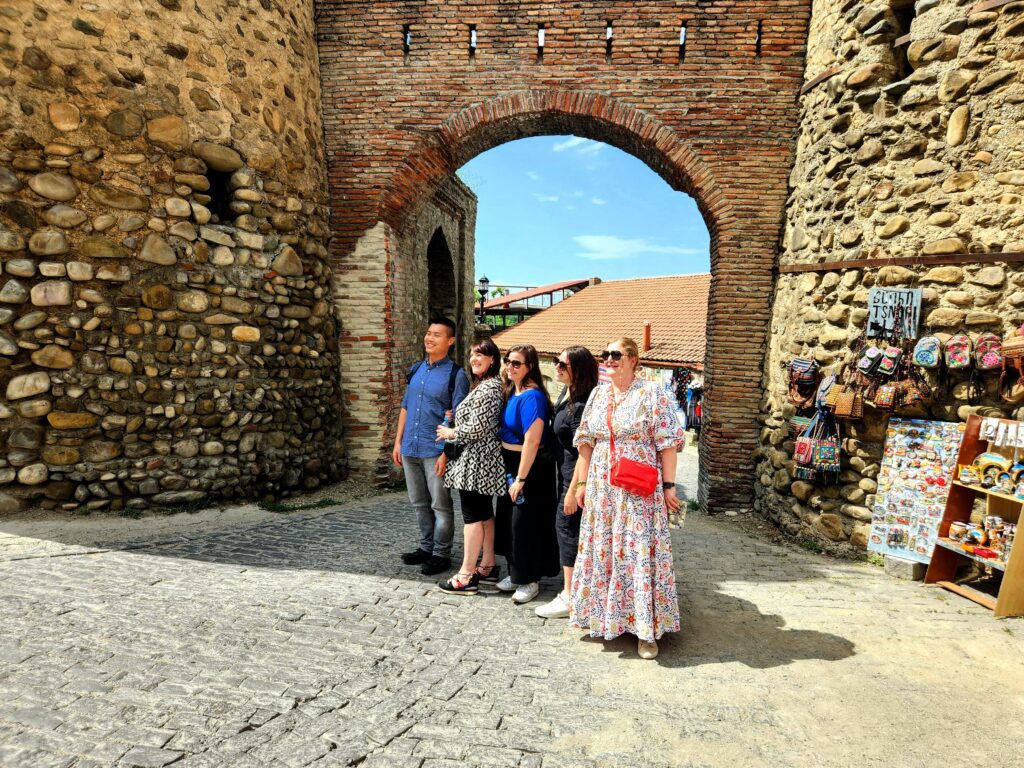
If you’re wanting to to explore Sighnaghi at a more leisurely pace, rental cars are an easy option. Just book a rental car for your trip to Sighnaghi through international booking sites like Expedia.
Car rental services in Sighnaghi offer a range of vehicles, which includes economy cars to SUVs, to suit the requirements of various group sizes and travel needs. Once in Sighnaghi, getting around is easy, as the town is easily walkable on foot.
Note: Only choose this option if you are a confident international driver. Georgian drivers are known for being – well some would say insane – and you need to take extra care when driving on Georgian roads.

So, wrapping up, I mentioned in the beginning that Sighnaghi is known as Georgia’s ‘City of Love’ and it’s easy to see why. It offers visitors old-world charm with cobblestone streets and pastel buildings, plus of course sensational Georgian wine and tasty food.
Whether you’re off on a romantic trip, a foodie expedition, or keen on a wine-tasting adventure, this little jewel in Kakheti Wine Country is bound to sweep you off your feet.
Frequently Asked Questions about Sighnaghi Georgia
What is Sighnaghi known for?
Sighnaghi located in the Kakheti region of Georgia is known for its historic and cultural heritage sites, charming cobblestone streets, and being a popular wedding venue due to its romantic allure. It’s often referred to as the “City of Love.”
Why is Sighnaghi called City of Love?
Sighnaghi is known as the “City of Love” because it has a popular wedding house where couples can marry – previously at any time of the day, today not so much, and it is associated with legends of love, such as the story of the artist Niko Pirosmani falling in love with a French actress.
What is the climate in Signagi?
Signagi has a mild Mediterranean-like climate with four distinct seasons, experiencing moderately cold winters and hot summers. The highest average temperature is 24.3°C / 75.74 °F in July (it’s really lovely), while the lowest is 0.2°C / 32.36 °F with lots of snow in January.
What is the best wine in Sighnaghi Georgia?
Oh how could you make me choose???
A top favourite is from Ampelo Hotel Kardanakhi 1888 Tsarapi.
Also Kerovani’s Sparkling wine is incredible on a hot summers day – but all of their wine is great too!
There are lots more incredible wines you can try – why not book a wine tour today and let us take you to our favourite wineries in this amazing wine region.
What is the significance of the name ‘Sighnaghi’?
The name ‘Sighnaghi’ is believed to have originated from the Turkish word ‘Siginak’, meaning shelter, reflecting its past role as a place of refuge behind it’s mighty walls, but also today as a place to escape the heat of Tbilisi.








